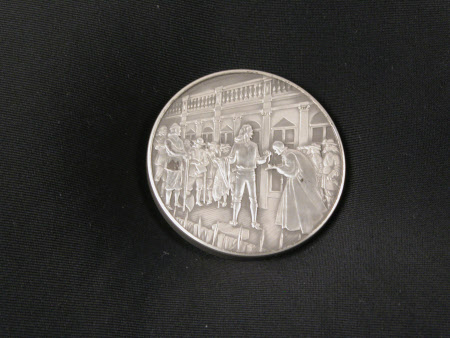The Execution of Charles I
Michael Rizzello (1926-2004)
Category
Coins and medals
Date
1993
Materials
Silver
Measurements
517 mm (Diameter)
Place of origin
United Kingdom
Order this imageCollection
Osterley Park and House, London
NT 773258
Summary
Silver, The Execution of King Charles I, medal designed by Michael Rizzello (1926-2004) and Michael Harvey (1931-2013), struck Royal Mint, Llantrisant, 1993. A silver medal commemorating the execution of King Charles I, on 30 January 1649. The concluding medal in a set of twelve issued by the Royal Mint in 1992 and 1993, to mark the 350th Anniversary of the English Civil War. The obverse, designed by Michael Rizzello, depicts Charles on the scaffold outside the Banqueting House, surrounded by soldiers. He is dressed in the thick shirts that he had asked to wear, so that he would not shiver in the cold January weather, making the crowd think that he was afraid. He hands his garter badge to Bishop William Juxon. The legend on the reverse, designed by Michael Harvey, reads 'THE EXECUTION OF CHARLES I / . 30 JANUARY 1649. / WE WILL CUT OFF HIS HEAD WITH THE CROWN UPON IT'. The legend refers to the tortured discussions within the High Court of Justice, set up by Parliament to decide on how the king should be tried. On Algernon Sidney arguing that the King could be tried by no court and no man by that court, Cromwell shouted 'I tell you we will cut off his head with the crown upon it!'
Full description
The Civil War was fought, mainly in England, between 1642 and 1649, the result of a long struggle for power between King Charles I (1600-49) and Parliament. After the defeat of the Royalists at the Battle of Preston, Charles had been taken to Windsor Castle, to await his fate. After much debate it was decided that the king should be tried for High Treason against the Realm of England. Although Charles’s high-handed and often petulant behaviour had made him in so many ways the author of his own misfortunes, there was no widespread appetite in the country for the fate that the king was to meet. In his last weeks Charles comported himself with a resigned dignity, which contributed to the aura of martyrdom that accompanied his death. At the three-day trial, he refused to enter a plea, denouncing the legitimacy of the court. Nevertheless he was found guilty and sentence pronounced: ‘This Court doth adjudge that he the said Charles Stuart, as a Tyrant, Traitor, Murderer and Public Enemy to the good people of this Nation, [and] shall be put to death, by the severing of his head from his body.’ The death warrant was drawn up, with 59 signatures, and legislation rushed through Parliament to prevent Charles’s son, the future Charles II, from succeeding his father. On the bitterly cold morning of 30th January, the king was led across St James’s Park to the Banqueting House, outside which a scaffold had been erected. Charles famously asked to wear two heavy shirts so that the assembled crowds would not see him shivering and take this for fear. After dignified final speeches, including the famous words ‘I go from a corruptible to an incorruptible crown; where no disturbance can be, no disturbance in the world’, he placed his head on the block and , after a short prayer, gave a sign to the executioner, who severed his head with a single blow. According to a young boy who was present, the blow of the axe was met with ‘such a groan as I have never heard before, and desire I may never hear again’. This was the final medal in a series of twelve issued by the Royal Mint at monthly intervals from June 1992, to celebrate the 350th anniversary of the outbreak of the English Civil War. The twelve medals illustrate the significant points in the conflict, from the raising of Charles I’s standard at Nottingham on 22 August 1642, to his execution on 30 January 1649. The designs of the obverses of the medals were commissioned from three leading contemporary artists, John Lobban, Michael Rizzello and Avril Vaughan, whilst the reverses, each of which contains a quotation relating to the subject of the medal, were designed by the distinguished lettering artist Michael Harvey, best-known for the names of celebrated Renaissance artists carved into the stonework of the Sainsbury Wing of the National Gallery. Michael Harvey’s original artwork for the series is in the Library of the University of Reading (URL MS 5115, file 392). The selection of the twelve episodes and the accompanying legend was devised by the historian of Tudor coinage Dr Christopher Challis. The medals were issued in silver and in bronze, in editions of 2,500 and 5,000, retailing at £84.50 or £49.50 per medal respectively. It was possible to buy the medals singly or as a set of twelve, the latter housed in an African walnut case. The whole series is in the collection at Osterley, but without the wooden case (NT 773248-773258, NT 773623). Jeremy Warren 2019
Provenance
Given to the National Trust in 1993 by George Child Villiers, 9th Earl of Jersey (1910-1998).
Marks and inscriptions
Reverse, legend: THE EXECUTION OF CHARLES I. / 30 JANUARY 1649. / WE WILL CUT OFF HIS HEAD WITH THE CROWN UPON IT
Makers and roles
Michael Rizzello (1926-2004), designer Michael Harvey (1931-2013), designer The Royal Mint, manufacturer

